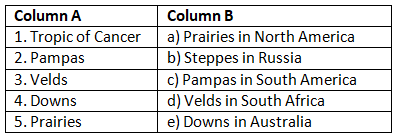Worksheet: The Prairies (Temperate Grasslands) | Be an Explorer 5: Book Solutions, Notes & Worksheets - Class 5 PDF Download
Q1: Multiple Choice Questions (MCQs).
(i) What is the meaning of the term 'Prairie'?
(a) Forest
(b) Grassland or Meadow
(c) Desert
(d) Plateau
(ii) In which hemisphere are the Prairies located?
(a) Northern Hemisphere
(b) Southern Hemisphere
(c) Eastern Hemisphere
(d) Western Hemisphere
(iii) Which river drains the Prairies region?
(a) Nile
(b) Mississippi
(c) Amazon
(d) Ganges
(iv) What is the climate of the Prairie region during winters?
(a) Hot and humid
(b) Cold and dry
(c) Warm and rainy
(d) Mild and windy
(v) Which wind blows in the Prairie region in spring?
(a) Monsoon
(b) Chinook
(c) Trade winds
(d) Typhoon
Q2: Fill in the Blanks.
(i) The Prairies are located in the interior of ____________.
(ii) The Prairie region has a ____________ climate, characterized by hot summers and cold, dry winters.
(iii) The Prairie region lies in a rain shadow area, which means it is away from the path of ____________.
(iv) The vegetation in most parts of the Prairies consists of tall to short ____________.
(v) The Prairies of the USA are sparsely populated, and most of the people are descendants of ____________ settlers.
Q3: Match the Column.

Q4: True or False.
(i) The Prairies are found in both the Northern and Southern Hemispheres.
(ii) The climate in the Prairie region is described as tropical.
(iii) Tall grasses in the Prairies grow quickly during autumn.
(iv) Bison, at one time, were abundant in the Prairies but are now extinct.
(v) Chicago is an essential center for ore-crushing factories.
You can access the solutions to this worksheet here.
FAQs on Worksheet: The Prairies (Temperate Grasslands) - Be an Explorer 5: Book Solutions, Notes & Worksheets - Class 5
| 1. What are the characteristics of the Prairies (Temperate Grasslands)? |  |
| 2. What types of plants and animals are found in the Prairies? |  |
| 3. How do the Prairies support agriculture? |  |
| 4. What are the threats to the Prairies? |  |
| 5. How can we conserve the Prairies? |  |
















